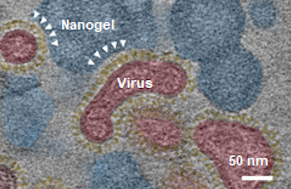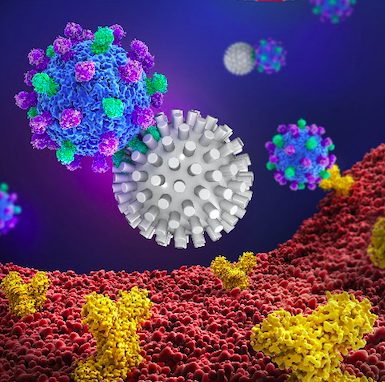New Study: New Strategies for Virus Inhibition
Highly flexible or spiky nanosystems by Berlin researchers open the door for new antiviral options against influenza viruses
№ 098/2020 from Jun 11, 2020
Berlin researchers have applied two new strategies based on multivalent nanosystems for making influenza A viruses (IAV) innocuous. The decisive factor in the development of these new strategies against influenza was the cooperation between scientists from different disciplines – chemistry, physics, virology, and imaging – the collaborative partners of Freie Universität Berlin, Humboldt University Berlin, and the Robert Koch Institute. The project was funded by the German Research Foundation (DFG) in the Collaborative Research Center 765 “Multivalence as a chemical principle of organization and action” of Freie Universität Berlin. The findings were published in three papers in the scientific journals Angewandte Chemie International Edition and Nano Letters.
In the first approach the flexibility and IAV binding with 250 nm sized spherical inhibitors’ are optimized in such a way that they bind and deforms to adapt onto the virus surface while in contact with the IAV. By doing this, these 3D nano inhibitors efficiently block the virus surface from getting in contact with cells upto 98.2%. As a result, virus cannot enter the cell and the infections is significantly reduced with picomolar concentrations of the inhibitor. Adaptability of these 3D nano inhibitors onto the virus surface was clearly shown by cryo-EM images. The virus inhibition was demonstrated by other biophysical techniques including Total internal reflection fluorescence (TIRF) and confocal laser scanning microscopy.
In another approach, 3D nano inhibitor with dual mode of action were prepared which can block the virus adhesion as well as the virus release from the cells. Furthermore, the surface topology of IAV virion was matched by using a spiky surface 3 D nano inhibitor. Because the surface of IAV is also spiky, the binding interface is increased as compared to smooth surfaces as proven by cryo-EM pictures. Such a combination of spiky surface and dual mode of action leads to a potent IAV inhibition (>99.9999% in cell culture) and it was active against three human IAV strains (A/X31 (H3N2), A/Panama (H3N2) and A/PR8 (H1N1)).
Seasonal and pandemic outbreaks of IAV have always challenged public health. Due to the unpredictable antigen shift and drifts and human infection by highly pathogenic animal IAV strains, IAV has been devastating. Therefore, inhibitors which can either completely block the virus adhesion onto cells or act by dual mode of action by inhibiting the binding and release of virus particles from cells will be efficient for virus infection. In principle, these strategies can be applied to other respiratory viruses and possibly to bacteria as well. The authors see the applicability of these strategies to address the current challenge of corona virus as well for which further developments are under progress.
Flexible nanogel-virus binding
Spiky surface nano particle-virus binding interface
Further Information
Publications
- Sumati Bhatia, Malte Hilsch, Jose Luis Cuellar Camacho, Kai Ludwig, Chuanxiong Nie, Badri Parshad, Matthias Wallert, Stephan Block, Daniel Lauster, Christoph Böttcher, Andreas Herrmann, Rainer Haag: Adaptive flexible sialylated nanogels as highly potent influenza A virus inhibitors. Angewandte Chemie International Edition, DOI 10.1002/anie.202006145
- Chuanxiong Nie, Badri Parshad, Sumati Bhatia, Chong Cheng, Marlena Stadtmüller, Alexander Oehrl, Yannic Kerkhof, Thorsten Wolff, Rainer Haag: Topology-matching design of an influenza neutralizing spiky nano-inhibitor with a dual mode of action. Angewandte Chemie International Edition, DOI 10.1002/anie.202004832
- Chuanxiong Nie, Marlena Stadtmüller, Hua Yang, Yi Xia, Thorsten Wolff, Chong Cheng, Rainer Haag, Spiky nanostructures with geometry-matching topography for virus inhibition, Nano Letters, DOI 10.1021/acs.nanolett.0c01723
Contact
Prof. Dr. Rainer Haag, Institute of Chemistry and Biochemistry, Freie Universität Berlin, Tel.: +49 30-838-52633, Email: haag@chemie.fu-berlin.de


